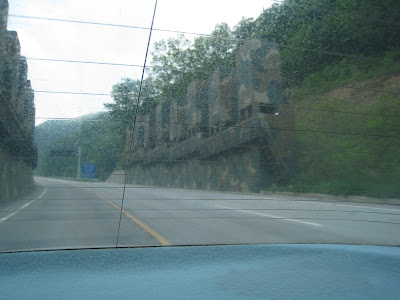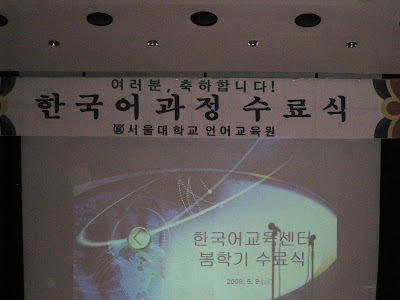The title of this post is a Korean rendering of
boulangerie, the French word for bakery.
French-style (or at least French-in-name) bakeries are very popular in Seoul these days, and there are several highly successful chains with branches all over the city. I decided to compile a photo gallery of some of them.
The first one, Cherbourg, is the least fancy of the lot. I took this picture in the long-distance bus terminal (
Gosok Teomineol 고속 터미널), which is where I catch the bus to Erma's parents'.

Bonespé is located on
Jongno 종로, a major downtown thoroughfare. I've only seen this one, but I think it must be a chain, since the sign identifies this as the "Jongno Branch". It looks very fancy.

Jean Boulangerie is in Nakseongdae 낙성대, not far from where I live. I always seem to be walking by on a Sunday, when it is closed.

Paris Baguette is one of the largest chains, and is pretty fancy. This one, not far from the Seoul National University subway station, has a café inside. It's where I took the picture of the
strawberry-cream bagel.

Tous les Jours is the most common chain store. I don't know of a neighborhood that lacks one.

And then, of course, there is my little neighborhood shop, Petit Amour.

There is something of linguistic interest here as well. For those of you who don't want to follow a slightly technical discussion, skip down to the next line of asterisks.
**********
Here are the names of the stores and their Korean renderings. I've also provided Korean pronunciations in International Phonetic Alphabet for those of you to whom it's meaningful. (Because there is no accepted IPA symbol for the Korean tense obstruents, I will simply double the letter.)
| Cherbourg | 쉘부르 | Shwelbureu | [ʃwɛlbuɾɯ]
|
| Bonespé | 보네스뻬 | Boneseuppe
| [ponɛsɯppɛ] |
| Jean Boulangerie | 쟝 블랑제리 | Jyang Beullangjeri
| [tʃaŋ pɯlaŋdʒɛɾi]
|
| Paris Baguette | 파리 바게뜨 | Pari Bagetteu
| [pʰaɾi pagɛttɯ]
|
| Tous les Jours | 뚜레쥬르 | Tturejyureu
| [ttuɾɛdʒuɾɯ]
|
| Petit Amour | 쁘띠 따무르 | Ppeutti Ttamureu
| [ppɯtti ttamuɾɯ]
|
What's interesting to me is the fact that the Korean transcriptions of these names show remarkable sensitivity to the actual pronunciation underlying the French orthography, and in particular to orthographic differences between French and English.
In particular, note the Korean rendering of the voiceless French sounds spelled with the letters
p and
t. In English, these letters generally represent aspirated sounds (i.e. they are accompanied with a puff of air), and therefore are rendered into Korean as ㅍ [pʰ] and ㅌ [tʰ] in the transliteration of English words. But in the names above, they are rendered as tense initials ㅃ [pp] and ㄸ [tt], reflecting their unaspirated pronunciation in French. (I've marked these in red above.) This seems to be quite consistent, except for "Paris", which as a place name already has a fixed Korean spelling of long standing.
Of particular note is the rendering of "Petit Amour", capturing the French liaison. The final
t of Petit is, in the Korean orthography, the beginning sound of the second word, 따무르 Ttamureu.
Also of note in these transcriptions:
1) The French
ch sound is always rendered in Korean with lip-rounding (note the [w] sound in the transcription of Cherbourg).
2) After Korean palatals ㅈ
j and ㅊ
ch, there is no distinction between palatalized and non-palatalized vowels. In other words, while one can spell 자
ja and 쟈
jya differently, the pronunciation is exactly the same: [tʃa]. Native Korean morphemes are always spelled without the
-y-. But foreign words are often spelled with the
-y-, probably because it makes them look orthographically foreign. Thus the English name John is usually spelled 쟌
jyan rather than 잔
jan, even though both are pronounced as
jan. We see this principle at work in the Korean renderings of Jean and Jours.
3) Nasalization of French vowels is represented orthographically by a following
-n. Koreans render this as ㅇ
ng, whereas for English words final
-n is rendered as ㄴ
n. You can see this principle at work twice in Jean Boulangerie.
4) French voiced obstruents (
b,
d,
g,
j) are, like their English counterparts, rendered with the plain series of Korean obstruents, which are pronunced as voiceless unaspirated (well, slightly aspirated) word-initially, and as voiced word-medially.
**********
The other day, perhaps just to drum up business, out in front of Petit Amour there was a balloon arch and speakers blaring music. The song playing when I took the picture was "Hot Stuff". You can recreate my experience by looking at the photo while listening to
this.

This kind of balloon arch is very commonly seen when Korean businesses have their grand opening, or as they call it in Korean, "Grand Open" (just like that, in Roman letters). But to really do a Grand Open right, you should have two scantily-clad dancing girls gyrating to the music.

Not long ago two construction projects took place near Petit Amour. The top floor of the building was renovated, and the street was repaved.

It all happened incredibly fast. I wanted to take a series of pictures documenting the process, but it was all over in one day.

Note, above, the thick electrical cables that run from the roof of the building down into Petit Amour. This is probably not to code!
I would like to mention here how incredibly hard-working the small business owners in Seoul are. The chef-owner of Petit Amour is there every single day (including weekends and holidays) from at least 7:00 am to 10:00 pm. (He might be open longer hours than that, but I haven't checked.) Restaurant owners, convenience store owners, and produce sellers in my neighborhood work similar hours. What recreation they enjoy (TV, newspapers, conversation) takes place during lulls in their work. And as tough as their lives must be, I have found in almost all cases that they are polite, friendly, and provide good service.























































